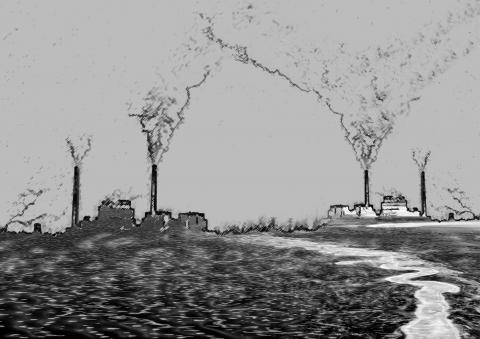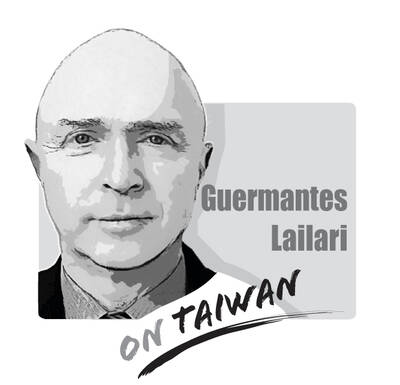The farm-to-table process in China starts in villages like Chenjiawan in the agricultural heartland. Food from the fields of Ge Songqing (葛松青) and her neighbors ends up in their kitchens or in the local market and, from there, goes to other provinces. The foods are Chinese staples: rice, cabbage, carrots, turnips and sweet potatoes.
However, the fields are ringed by factories and irrigated with water tainted by industrial waste. Levels of toxic heavy metals in the wastewater here are among the highest in China, and residents fear the soil is similarly contaminated. Though they have no scientific proof, they suspect that a spate of cancer deaths is linked to the pollution and worry about lead levels in the children’s blood.
“Of course I’m afraid,” said Ge, in her 60s, pointing to the smokestacks looming over her fields and the stagnant, algae-filled irrigation canals surrounding a home she shares with a granddaughter and her husband, a former soldier. “But we don’t do physical checkups. If we find out we have cancer, it’s only a burden on the children.”

Illustration: June Hsu
With awareness of China’s severe environmental degradation rising, there has been a surge of anxiety in the last year among ordinary Chinese and some officials over soil pollution in the country’s agricultural centers and the potential effects on the food chain. In recent years, the government has conducted widespread testing of soil across China, but it has not released the results, adding to the fear and making it more difficult for most Chinese to judge what they eat and pinpoint the offending factories.
An alarming glimpse of official findings came on Monday, when Chinese Vice Minister of Land and Resources Wang Shiyuan (王世元) said at a news conference in Beijing that 3.2 million hectares of China’s farmland, equal to the size of the state of Maryland in the US, had become so polluted that planting crops on it “should not be allowed.”
A signal moment came in May, when officials in Guangdong Province said they had discovered excessive levels of cadmium in 155 batches of rice collected from markets, restaurants and storehouses. Of those, 89 were from Hunan Province, where Ge farms.
The report set off a nationwide scare. In June, China Daily, an official, English-language newspaper, published an editorial saying that “soil contaminated with heavy metals is eroding the foundation of the country’s food safety and becoming a looming public health hazard.”
One-sixth of China’s arable land — nearly 20 million hectares — suffers from soil pollution, according to a book published this year by the Ministry of Environmental Protection. The book, Soil Pollution and Physical Health, said that more than 13 million tonnes of crops harvested each year were contaminated with heavy metals, and that 9 million hectares of farmland were affected by pesticides.
However, the government has refused to divulge details of the pollution, leaving farmers and consumers in the dark about the levels of contaminants in the food chain. The soil survey, completed in 2010, has been locked away as a “state secret.”
“We think it’s always the right of the public to know how bad the situation is,” said Ma Tianjie (馬天杰), an advocate at Greenpeace East Asia who is researching toxic soil. “The Chinese public can accept the fact that our environment is polluted. The important thing is to give them the means to challenge polluters and improve the environment, and not just keep them in the dark.”
There has been some acknowledgment of the problem by top officials. In January last year, the State Council, China’s Cabinet, announced that it would set up systems to comprehensively monitor soil pollution by 2015 and promote pilot projects for treatment.
Scholars say soil pollution is especially acute in Hunan Province, China’s rice bowl. In 2012, Hunan produced 17 million tonnes of rice, 16 percent of the national total, according to one market research company.
The province is also one of China’s top producers of nonferrous metals. As a result, it is the leading polluter of cadmium, chromium, lead and nonmetal arsenic, according to data collected in 2011 by the Institute of Public and Environmental Affairs, a research group based in Beijing.
That year, the province was responsible for 41 percent of the nation’s cadmium pollution when measured by its presence in industrial wastewater. The number has not dropped below 30 percent since 2004, when the data were first collected by the group. The wastewater is discharged in rivers, where it flows into irrigation channels.
“There’s this pressure from the central government on Hunan to maintain a high level of yield for rice production,” Ma said. “On the other hand, rice production never gives you the same kind of GDP growth that industrial development gives you.”
Hunan’s abundance of raw metals has led to a push by provincial Chinese Communist Party leaders to develop mining and smelting there further, leaving officials caught in what Ma calls a clash of two imperatives: “They have to feed the country with their rice, but they want to grow their economy.”
Among the heavy metals seeping into Hunan’s crops, the worst may be cadmium, which at high levels has been linked to organ failure, weakening of bones and cancer, scientists said.
“Cadmium has a tendency to accumulate in the kidney and liver,” Guangdong Institute of Eco-environment and Soil Sciences academic Chen Nengchang (陳能場) said. “When the accumulation reaches a certain point, it will pose a serious health risk for the organs.”
Cadmium that accumulates in rice plants gets not only into the rice on China’s tables, but also into animals’ meat, since the husks are fed to farm animals. There is no public data, though, that show the level of cadmium pollution in food.
HIGH CANCER RATES
Increasingly, Chinese news organizations are reporting on clusters of villages that have high rates of cancer, raising questions about the potential link between cancer and various forms of pollution. Some scientists are now conducting studies.
In July, the Chinese Center for Disease Control and Pollution published some findings from a study that drew a direct connection between pollution of the Huai River, which crosses several provinces in central China, and high rates of cancer among people living by the river. In Hunan, and particularly in the Chenjiawan area administered by Hengyang City, which includes Ge’s village, stories of cancer are common.
One woman in the village of Liujiacun said her husband had died in his late 50s of liver cancer.
“He didn’t do heavy labor, didn’t smoke and he would drink only a little bit,” said the widow, who gave only her surname, Li.
As in nearby villages, crops here appear wilted, and the village well is clogged with green muck. These were all sharp changes from Li’s childhood, she said.
Twenty people still live in Chenjiawan now, down from a population of about 100 in 2007, most of them elderly, Ge said, adding that many recent deaths had been from cancer.
There is no public data drawing a direct connection between these cases and the factories that loom over the farmland. However, a 2009 study published in a Chinese journal said that the area’s main crops were “at a high risk of heavy metal contamination,” and that only less than half could be rated “secure” or “good.”
Chinese farmers “have such a profound connection with the land,” Chen said. “Since China’s household registration system makes it difficult for them to relocate to other areas, there is a sense of fatalism, and they accept whatever comes their way.”
That sense of futility ripples throughout central Hunan. In one part of Hengyang, a mound of industrial waste that has destroyed adjacent farmland has drawn outraged comments from villagers on the Internet. However, they expect no action because the nearby factories are tied to local officials, villagers said in interviews.
“There’s no way to close these factories because of local protectionism,” said one farmer, Wang, who wanted to be identified only by his surname for fear of retribution.
For Hunan officials, the mines and factories around Hengyang are central to maintaining the province’s leading role in the production of nonferrous metals, essential for industrial processes like the manufacture of lead-acid car batteries.
“It’s difficult to lobby against those companies,” said Sun Cheng (孫成), a spokesman for Green Hunan, an advocacy group.
Hunan officials are eager to expand the nonferrous metals industry. In a development plan for the five years ending in 2015, officials have pledged to increase the industry’s revenue by an annual rate of 18 percent and have approved 80 new projects that have a total investment of US$8.5 million.
Given the nationwide health risks, some environmental officials in Beijing have praised recent experiments done by scientists that show certain plants could help clean the soil by absorbing poisons. Still, there has been no sign of action on the State Council’s announced goal for comprehensive monitoring and treatment of soil pollution.
Many farmers working their ravaged lands remain fearful and fatalistic.
“You’re born on this earth, you grow up on this earth, and you can’t do anything about it,” Ge said, sitting in an alley next to a pail of carrots. “Those who are most vulnerable have died. We’re still here wasting away.”
Additional reporting by Chris Buckley
The fallout from the mass recalls and the referendum on restarting the Ma-anshan Nuclear Power Plant continues to monopolize the news. The general consensus is that the Democratic Progressive Party (DPP) has been bloodied and found wanting, and is in need of reflection and a course correction if it is to avoid electoral defeat. The Chinese Nationalist Party (KMT) has not emerged unscathed, either, but has the opportunity of making a relatively clean break. That depends on who the party on Oct. 18 picks to replace outgoing KMT Chairman Eric Chu (朱立倫). What is certain is that, with the dust settling

“History does not repeat itself, but it rhymes” (attributed to Mark Twain). The USSR was the international bully during the Cold War as it sought to make the world safe for Soviet-style Communism. China is now the global bully as it applies economic power and invests in Mao’s (毛澤東) magic weapons (the People’s Liberation Army [PLA], the United Front Work Department, and the Chinese Communist Party [CCP]) to achieve world domination. Freedom-loving countries must respond to the People’s Republic of China (PRC), especially in the Indo-Pacific (IP), as resolutely as they did against the USSR. In 1954, the US and its allies
Mainland Affairs Council Deputy Minister Shen You-chung (沈有忠) on Thursday last week urged democratic nations to boycott China’s military parade on Wednesday next week. The parade, a grand display of Beijing’s military hardware, is meant to commemorate the 80th anniversary of Japan’s surrender in World War II. While China has invited world leaders to attend, many have declined. A Kyodo News report on Sunday said that Japan has asked European and Asian leaders who have yet to respond to the invitation to refrain from attending. Tokyo is seeking to prevent Beijing from spreading its distorted interpretation of wartime history, the report
Indian Prime Minister Narendra Modi arrived in China yesterday, where he is to attend a summit of the Shanghai Cooperation Organization (SCO) with Chinese President Xi Jinping (習近平) and Russian President Vladimir Putin today. As this coincides with the 50 percent US tariff levied on Indian products, some Western news media have suggested that Modi is moving away from the US, and into the arms of China and Russia. Taiwan-Asia Exchange Foundation fellow Sana Hashmi in a Taipei Times article published yesterday titled “Myths around Modi’s China visit” said that those analyses have misrepresented India’s strategic calculations, and attempted to view